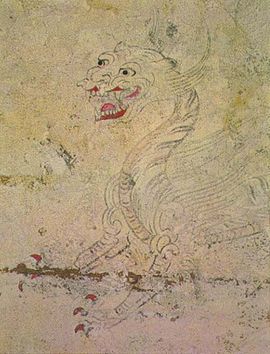White Tiger (Chinese Star Constellation)
| White Tiger | |
|---|---|

|
|
| Chinese name | |
| Long characters | 白虎 |
| Abbreviation | 白虎 |
| Pinyin | Bái Hǔ |
| Jyutping | baak 6 fu 2 |
| Vietnamese name | |
| Quốc Ngữ | Bạch Hổ |
| Hán tự | 白虎 |
| Korean name | |
| Hangeul | 백호 |
| Hanja | 白虎 |
| Revised Romanization | Baek-ho |
| Japanese name | |
| Kanji | 白虎 |
| Hiragana | び ゃ っ こ |
| Hepburn | Byakko |
The white tiger ( Chinese 白虎 , Pinyin Bái Hǔ ) is a symbol in the Chinese star constellations . It is also called the "White Tiger of the West" ( 西方 白虎 , Xīfāng Bái Hǔ ) and stands for autumn and the west .
It was used not only by Chinese, but also by Japanese, Korean and Vietnamese cartographers.
The seven houses of the White Tiger
In Chinese astrology , the four symbols are each assigned seven houses. For the white tiger these are:
- Legs ( 奎 , kuí )
- Band ( 婁 / 娄 , Lóu )
- Belly ( 胃 , Wèi )
- hairy head ( 昴 , Mǎo )
- Network ( 畢 / 毕 , Bì )
- Turtle beak ( 觜 , zī )
- three stars ( 參 / 参 , Shēn )
background
In Asian culture, the tiger is considered the "king of animals". In ancient China he was the "king of the mountains" who ruled over the animals in the mountains. According to legend, it was believed that a tiger would turn white after 500 years and live for 1000 years. In Daoism the white tiger, also known as the “white tiger of the west”, was a demonic animal and a dreaded star deity, but it was also the guardian of Daoist temples together with the azure dragon Qinglong .
See also
literature
- Josef Guter: Lexicon of the gods and symbols of the ancient Chinese. Marix, Wiesbaden 2004, ISBN 3-937715-04-5 , pp. 345-346.
- Jeremy Roberts: Chinese Mythology AZ . 2nd Edition, Chelsea House Publications 2009, ISBN 978-1-60413-436-0 , pp. 125, 132.
Web links
- Chinese Astronomy: The Chinese Sky (English)
Individual evidence
- ^ Vratislav Mazák: The tiger. P. 9
- ↑ Save China's Tigers: Tiger Culture ( Memento from February 12, 2009 in the Internet Archive )
- ↑ Jeremy Roberts: Chinese Mythology AZ . P. 132